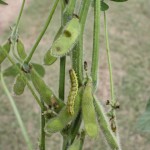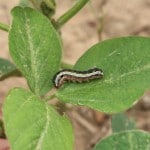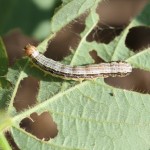As expected, corn earworm infestations in soybean are requiring treatment in a number of fields. Thus far most of the action has occurred in the Mississippi River bottoms, but problems appear to be spreading northward and east from Shelby, Tipton and Lauderdale Counties. There have also been several reports of large populations of yellowstriped armyworms mixed with lower levels of fall armyworm.
Pest identification is very important in determining if treatment is needed because corn earworms will concentrate their feeding on flowers and pods, whereas the other pests will primarily target foliage and it takes higher numbers to justify treatment. If you are unsure about how to distinguish the various caterpillar species be sure to get some help, and there are a number of good on-line resources and photographic identification guides such as the following: MSU Publication 2543, Soybean Insect Identification. The most common caterpillars at this time are corn earworms, yellowstriped and fall armyworms, and green cloverworms. I’ve included some pictures below (click to enlarge).
- The treatment threshold for corn earworm in flowering soybean is when the field averages 9 or more larvae per 25 sweeps or 3 or more per foot of row (using a drop cloth). This may seem high, but the threshold was actually recently reduced. Serious infestation can easy exceed 1 larva per sweep, and there have been reports of up to two larvae per sweep in Tipton County. Corn earworms may be found in pre-flowering soybeans where they will cause some defoliation, but infestations during flowering are a much greater concern where they will feed on flowers and pods. Corn earworms infestations often begin during early flowering and peak at R3, but they can persist later.
- For yellowstriped and fall armyworms in flowering soybean, treatment would be recommended anytime defoliation exceeds 30%. Besides defoliation, these high populations may also nibble of flowers and pods. So you might consider treatment if larval counts are high (> 1 per sweep), or at least keep a very close eye on infested fields. There are at least a few fields that are currently exceeding these levels. I’ve had reports in fields ranging from pre- to full-flower (R2).
- It takes very high populations of green cloverworm to cause enough defoliation to justify treatment. They are the only caterpillar that will have three pair of prolegs. The other species mentioned above have four pair of prolegs. They are mostly green in color and will move in a looping fashion when small. The often wriggle violently if you poke and prod them in the palm of your hand. Some states, including Tennessee, use a sweep net threshold of 150 larvae per 100 sweeps after fields have started flowering (R1) or anytime defoliation exceeds 30%. It is unusual to treat specifically for green cloverworms, but they can contribute to defoliation caused by other pests.
Common Treatment Options:
-
Synthetic pyrethroids such as Asana XL, Baythroid, Brigade, Fanfare, Discipline, Declare, Karate and Mustang Max will normally do a good job of controlling all of the pests above. However, reports from our neighbors indicate that pyrethroid applications are leaving some corn earworms in the field. Consider adding 0.5 lb of Orthene/Acephate, especially if pressure is very high. Reports are that this combination is performing well. This option will do an excellent job of killing stink bugs and most other insects in the field (including beneficial insects). So keep in mind this may predispose you to spraying later for soybean loopers. The good news is that soybean looper infestations have so far been mild to our south.
-
Belt SC is a new insecticide from Bayer CropSciences. It’s activity in primarily restricted to caterpillar pests. It’s lowest labeled rate is 2 oz/acre, but my limited testing has indicated that 1.5 oz/acre should work well for corn earworm infestations, but keep in mind you have no recourse for complaints if a lower than labeled rate does not provide adequate control. This product MAY provide more residual control than some other options, but I’ve not seen enough data for corn earworms to be convinced.
-
Steward is a DuPont product. It performed well in controlling corn earworm last year at a rate of 6 oz/acre, and I also had good reports from the field. Like Belt, it’s activity is mostly restricted to caterpillar pests.
-
Tracer is a Dow AgroSciences product and at a rate of 1.5-2 oz/acre should provide good control, again with little activity on non-caterpillar pests and it is relatively expensive.






The time is soon approaching when I will spray a fungicide on my seed soybean acres. I am growing 5.4 and 5.7 varieties for a local seed dealer. An Area Extension leader in MS who writes a weekly column for AgFax is suggesting growers add Dimilin to their fungicide plus the appropriate insecticide if they have a particular pest at threshhold numbers. Would we benefit from the inclusion of Dimilin with our fungicide even if there is not a particular pest that needs to be targeted?
Richard – I’ve done some testing with Dimilin over the years, including this year and last year. Dr. Newman has done a lot of testing over the years. To be blunt, Dr. Newman and I have not been able to show value in Tennessee. It will eliminate green cloverworms for a long spell, but this pest rarely causes economic loss. It has marginal effects on stink bugs, soybean loopers and other common pests. In my tests last year, I lost any potential value because I had to come back a few weeks later to spray stink bugs after treating with Dimilin. I won’t speak for my counterparts in Mississippi, but based on my conversations with them, this is not a normally recommended practice.